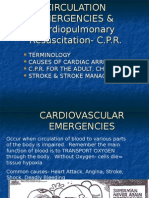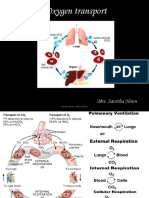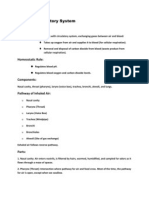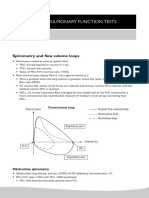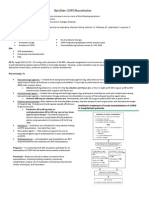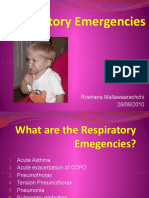0 ratings0% found this document useful (0 votes)
158 viewsOxygen Therapy: Citra Rencana Perangin Angin Anesthesiology Division Faculty of Medicine UKRIDA
Oxygen Therapy: Citra Rencana Perangin Angin Anesthesiology Division Faculty of Medicine UKRIDA
Uploaded by
Paulus Apostolos Hasintongan SianturiOxygen therapy involves administering oxygen at concentrations greater than ambient air to treat or prevent hypoxia. It is indicated when tissue oxygenation is impaired. Different devices can be used to deliver oxygen at varying concentrations depending on a patient's condition and needs. Nasal cannulas and masks are commonly used for low-moderate oxygen delivery while venturi masks and non-rebreather masks provide higher concentrations. Proper administration and monitoring is important to avoid complications like oxygen toxicity.
Copyright:
© All Rights Reserved
Available Formats
Download as PPT, PDF, TXT or read online from Scribd
Oxygen Therapy: Citra Rencana Perangin Angin Anesthesiology Division Faculty of Medicine UKRIDA
Oxygen Therapy: Citra Rencana Perangin Angin Anesthesiology Division Faculty of Medicine UKRIDA
Uploaded by
Paulus Apostolos Hasintongan Sianturi0 ratings0% found this document useful (0 votes)
158 views56 pagesOxygen therapy involves administering oxygen at concentrations greater than ambient air to treat or prevent hypoxia. It is indicated when tissue oxygenation is impaired. Different devices can be used to deliver oxygen at varying concentrations depending on a patient's condition and needs. Nasal cannulas and masks are commonly used for low-moderate oxygen delivery while venturi masks and non-rebreather masks provide higher concentrations. Proper administration and monitoring is important to avoid complications like oxygen toxicity.
Original Title
Oxygen Therapy
Copyright
© © All Rights Reserved
Available Formats
PPT, PDF, TXT or read online from Scribd
Share this document
Did you find this document useful?
Is this content inappropriate?
Oxygen therapy involves administering oxygen at concentrations greater than ambient air to treat or prevent hypoxia. It is indicated when tissue oxygenation is impaired. Different devices can be used to deliver oxygen at varying concentrations depending on a patient's condition and needs. Nasal cannulas and masks are commonly used for low-moderate oxygen delivery while venturi masks and non-rebreather masks provide higher concentrations. Proper administration and monitoring is important to avoid complications like oxygen toxicity.
Copyright:
© All Rights Reserved
Available Formats
Download as PPT, PDF, TXT or read online from Scribd
Download as ppt, pdf, or txt
0 ratings0% found this document useful (0 votes)
158 views56 pagesOxygen Therapy: Citra Rencana Perangin Angin Anesthesiology Division Faculty of Medicine UKRIDA
Oxygen Therapy: Citra Rencana Perangin Angin Anesthesiology Division Faculty of Medicine UKRIDA
Uploaded by
Paulus Apostolos Hasintongan SianturiOxygen therapy involves administering oxygen at concentrations greater than ambient air to treat or prevent hypoxia. It is indicated when tissue oxygenation is impaired. Different devices can be used to deliver oxygen at varying concentrations depending on a patient's condition and needs. Nasal cannulas and masks are commonly used for low-moderate oxygen delivery while venturi masks and non-rebreather masks provide higher concentrations. Proper administration and monitoring is important to avoid complications like oxygen toxicity.
Copyright:
© All Rights Reserved
Available Formats
Download as PPT, PDF, TXT or read online from Scribd
Download as ppt, pdf, or txt
You are on page 1of 56
OXYGEN THERAPY
Citra Rencana Perangin angin
Anesthesiology Division
Faculty of Medicine UKRIDA
Definition
Oxygen therapy is the administration of
oxygen at concentrations greater than
ambient air (21%)
With the intent of treating or preventing
the symptoms and manifestation of
hypoxia
Oxygen therapy is indicated whenever
tissue oxygenation is impaired
Tissue Oxygenation
FiO2
Ventilation:
Resp Center
Airway
Alveoli PaO2
Pillows: Ms Bones
Diffusion
Perfusion
CVS:
COP
Volume
Peripheral circulation
Hb: Bind - Release
Anemia O2 Delivary
Abnormal ex CarboxyHb
2,3 DPG
Utilization by cell:
Cyanide poisoning
Oxygen is a drug. It has:
Physiological actions
Pharmacological actions
A dose-response relationship
Adverse effects
Topics
Types of Hypoxia
Signs and symptoms of Hypoxia
Indications
Contraindications and precautions
Delivery systems
Mechanisms of Hypoxia
Aerobic Metabolism requires:
O2 Utilization
O2 Delivery O2 Utilization
O2 Delivery
Shift from aerobic to anaerobic metabolism
Increase Lactic acid
Progressive Acidosis
Cell Death
Types of Hypoxia
Hypoxic Hypoxia
Circulatory Hypoxia
Hemic Hypoxia
Demand Hypoxia
Histotoxic Hypoxia
Hypoxic Hypoxia
Low PaO
2
(arterial oxygen tension)
secondary to FiO
2
< 0.21 or decreased
barometric pressure (altitude)
Impaired ventilation secondary to
neuromuscular weakness or narcotic
overdose
Impaired oxygenation secondary to
Pulmonary Fibrosis, ARDS
Circulatory Hypoxia
Inadequate pumping of the blood from
the hearts to tissues, maybe secondary to
disorders causing decreased cardiac
output such as MI, hypovolemic,
hypotension, poor supply of arteries. If
the patient has myocardial ischemia
supplemental O
2
is definitely indicated
Hemic Hypoxia
Decreased oxygen carrying capacity as in
anemia or carbon monoxide poisoning
Demand Hypoxia
Increased tissue consumption of oxygen in
hypermetabolic states: like fevers
Histotoxic Hypoxia
Utilization of oxygen is abnormal such as
in cyanide poisoning
Signs and symptoms of Hypoxia
Tachypnea, dyspnea, hyperpnea
Tachycardia, dysrythmias, pulse changes,
hypertension
Anemia, polycythemia
Restlessness, disorientation, lethargy
Cyanosis, digital clubbing
Indication
Cardiac arrest
Respiratory arrest
Respiratory failure type I & II
Cardiac failure
Myocardial infarction
Shock of any cause
Increased metabolic demands
Post operative states
Carbon monoxide poisoning
Contraindication & precautions
With PaO
2
> 60, patients with chronic CO
2
elevations may experience ventilatory
depression
With FiO
2
> 50%, oxygen toxicity, absorption
atelectasis, or depression of ciliary and/or
leukocytic function
Administer with caution to patients receiving
bleomycin cancer therapy
Fire hazard is increased in the presence of
oxygen concentration.
Cautions For Oxygen Therapy
Oxygen toxicity can
occur with FIO2 >
50% longer than 48
hrs
Suppression of
ventilation will lead
to increased CO2 and
carbon dioxide
narcosis
Danger of fire
Infection
Oxygen cascade
mmHg
Inspired air 150
Alveolar 103
Arterial 100
Capillary 51
Tissue 20
Mitochondrial 1-20
ALVEOLUS
Lung capillary
Free air:
PiO2 : 20.9 % x 760 = 159
mmHg
PiCO2 : 0.04 % x 760 = 0.3 mmHg
PiN2 : 78.6 % x 760 = 597mmHg
PiH2O : 0.46 % x 760 = 3.5 mmHg
N2 H2O
O2
PAO2:
104
mmHg
CO2
PACO2:
40 mmHg
O2
PaO2:
40 mmHg
O2
PaO2:
102
mmHg
CO2
PaCO2:
45
mmHg
CO2
PaCO2:
40
mmHg
Diffusion
process
PAN2:
573
mmHg
PAH2O:
47 mmHg
Oxygen dissociation curve
Oxygen dissociation curve
Factors increasing P50 (curve shift to right)
Hyperthermia
Decreased pH (acidemia)
Increased PCO
2
(Bohr effect)
Increased 2,3 DPG
Oxygen dissociation curve
Factors decreasing P50 (curve shifts to left)
Hypothermia
Increased pH (alkalaemia)
Decreased PCO
2
Decreased 2,3 DPG
Fetal haemoglobin
Carboxyhaemoglobin
methaemoglobin
Delivery systems
= VARIABLE PERFORMANCE SYSTEMS
1. FiO
2
depends upon oxygen flow
2. Device factors
3. Patients factors
Classification of Oxygen Delivery
Systems
Low flow systems
contribute partially to inspired gas client
breathes
do not provide constant FIO2
Ex: nasal cannula, simple mask , non-re
breather mask , Partial rebreather mask
High flow systems
deliver specific and constant percent of
oxygen independent of clients breathing
Ex: Venturi mask,, trach collar, T-piece
VARIABLE PERFORMANCE
SYSTEMS
No capacity system
Small capacity systems
Large capacity systems
No capacity system
Nasal catheters at low flow rates
( < 2 L/i )
Small capacity system
Nasal catheters at high flows
Simple, semi-rigid plastic masks (MC,
Edinburgh, Harris, Hudson)
Tracheostomy masks
Laryngeal mask and simple plastic facemask
T-piece circuit
Face tent
Large capacity system
Soft plastic masks (e.g. Pneumask,
polymask, oxyaire)
Apparatus/devices for oxygen
therapy
Nasal catheters
Semi-rigid mask (e.g. MC, Edinburgh, Hudson, Harris)
Venturi-type mask
Soft plastic masks (e.g. Pneumask, Polymask Oxyaire)
Ventilators
Anaesthesia circuits
CPAP circuits
Plastic head hood
Oxygen tent/cot
Incubator
Methods of oxygen administration:
1- Nasal cannula
Nasal cannula (prongs):
It is a disposable.
plastic devise with two protruding
prongs for insertion into the nostrils,
connected to an oxygen source.
Used for low-medium concentrations
of Oxygen (24-44%).
Face mask
The simple Oxygen mask
The partial rebreather mask:
The non rebreather mask:
The venturi mask:
The simple Oxygen mask
Simple mask is made of
clear, flexible , plastic or
rubber that can be
molded to fit the face.
It is held to the head
with elastic bands.
Some have a metal clip
that can be bent over
the bridge of the nose
for a comfortable fit.
The simple Oxygen mask
It delivers 35% to 60% oxygen .
A flow rate of 6 to 10 liters per minute.
It has vents on its sides which allow
room air to leak in at many places,
thereby diluting the source oxygen.
Often it is used when an increased
delivery of oxygen is needed for short
periods
(i.e., less than 12 hours).
The partial rebreather mask:
The mask is have with a reservoir bag must
romaine inflated during both inspiration &
expiration
It collection of the first parts of the
patients' exhaled air.
It is used to deliver oxygen concentrations
up to 80%.
The partial rebreather mask
The oxygen flow rate
must be maintained at a
minimum of 6 L/min to
ensure that the patient
does not rebreathe large
amounts of exhaled air.
The remaining exhaled
air exits through vents.
The non rebreather mask
This mask provides the
highest concentration of
oxygen (95-100%) at a flow
rate6-15 L/min.
It is similar to the partial
rebreather mask
except two one-way valves
prevent conservation of
exhaled air.
The bag is an oxygen
reservoir
The non rebreather mask
When the patient exhales
air.
the one-way valve closes
and all of the expired air
is deposited into the
atmosphere, not the
reservoir bag.
In this way, the patient is
not rebreathing any of the
expired gas.
Venturi mask
It is high flow
concentration of oxygen.
Oxygen from 40 - 50%
At liters flow of 4 to 15
L/min.
The mask is so
constructed that there is
a constant flow of room
air blended with a fixed
concentration of oxygen
The venturi mask
is designed with wide- bore tubing and various
color - coded jet adapters.
Each color code corresponds to a precise
oxygen concentration and a specific liter flow.
The venturi system,
Room air dilutes the oxygen entering the
tubing to a certain concentration
The amount of air drawn in is determined by
the size of the orifice (jet adapter).
The venturi mask
The narrower the jet adapter,
the greater the air dilution, and the
lower the concentration of oxygen.
It is used primarily for patients with
chronic obstructive pulmonary disease
Tracheostomy Collar/ Mask
Inserted directed into trachea
Is indicated for chronic o2
therapy need
O2 flow rate 8 to 10L
Provides accurate FIO2
Provides good humidity.
Comfortable ,more efficient
Less expensive
T-piece
Used on end of
ET tube when
weaning from
ventilator
Provides
accurate FIO2
Provides good
humidity
Devices
Suggested
flow
rate(L/min)
O2%
Advantage
s
Disadvanta
ges
Cannula
1liter
2liter
3liter
4liter
5liter
6liter
24%
28%
32%
36%
40%
44%
Light
weight
,comfortabl
e
,inexpensiv
e ,
continuous
use with
meals and
activities.
Nasal
mucosa
,drying ,
variable
fio2
Catheter
1-6liter
23-40%
Inexpensiv
e
Variable
fio2,require
s frequent
change
,gastric
distension
can occur
Simple mask
5liter
6liter
8liter
40%
45-50%
55-60%
Simple to
use ,
inexpensive
Poor
fitting,variabl
e fio2,must
remove to
feeding .
Mask partial
re-breather
6-15liter
70-90%
Moderate O2
concentratio
n
Warm,poor
fitting ,must
be removed
to feeding
Mask non-
breather
NRM
12liter
82-100%
High o2
concentratio
n
Poor fitting
Mask
nonbrather
NRM
12liter
82-100%
High o2
concentrati
on
Poor fitting
Mask
venturi
4 -6liter
6-8liter
24,26,28
30,35,40
Provide
low levels
of
supplemen
tal o2.
Precise
fio2
additional
humidity
availabe
Must be
removed to
eat
Mask
aerosal
8-10
30-100%
Good
humidity,ac
curate fio2
Uncomfort
able some.
Trachestom
y colar
8-10liter
30-100%
Good
humidity,ac
curate fio2
`uncomfort
able some
T-piece
briggs
8-10 liter
30-100%
Same as
trachestom
y colar
Heavy with
tubing
Face tent
8-10 liter
30-100%
Fairly
accurate
fio2
Bulky
compreso
m
Hazards of Oxygen therapy
CO
2
Narcosis
O
2
toxicity
CO
2
Narcosis
When high FiO
2
s are administered to
patients dependent on a hypoxic
(chemoreceptor) drive
Oxygen toxicity
Neurological effects (Paul Bert effects)
Lung toxicity
Retrolental fibroplasia
Barotrauma
HYPERBARIC OXYGEN THERAPY
Hyperbaric oxygen (HBO) therapy delivers
100% oxygen at a pressure above
atmospheric, in a pressurized multi or one
man chamber
HYPERBARIC OXYGEN THERAPY
Indications:
Carbon monoxide poisoning
Burns
Gas gangrene
Osteomyelitis
Osteoradionecrosis
Crush injuries
Ischaemic skin grafts
HYPERBARIC OXYGEN THERAPY
Complications
Barotrauma to ears, sinuses and lungs
Oxygen toxicity
Grand mal fits
Changes in visual acuity
PAEDIATRIC OXYGEN THERAPY
Oxygen headbox or hood
Incubator
Oxygen cot/tent
Thank you for
Your Attention
You might also like
- PediculosisDocument3 pagesPediculosisDarkCeades60% (5)
- Cast Metal Restorations 2021Document56 pagesCast Metal Restorations 2021nandani kumariNo ratings yet
- Mechanical VentilationDocument13 pagesMechanical VentilationNithiya NadesanNo ratings yet
- 9) Understand The Definition, Causes and Management of Hypoxia During AnaesthesiaDocument7 pages9) Understand The Definition, Causes and Management of Hypoxia During AnaesthesiaTan Hing LeeNo ratings yet
- Respiratory Therapy: 66 Test Questions Student Respiratory Therapists Get Wrong Every Time: (Volume 2 of 2): Now You Don't Have Too!: Respiratory Therapy Board Exam Preparation, #2From EverandRespiratory Therapy: 66 Test Questions Student Respiratory Therapists Get Wrong Every Time: (Volume 2 of 2): Now You Don't Have Too!: Respiratory Therapy Board Exam Preparation, #2No ratings yet
- Basics and modern practice of nasal high-flow therapyFrom EverandBasics and modern practice of nasal high-flow therapyRating: 5 out of 5 stars5/5 (1)
- Oxygen Delivery DevicesDocument19 pagesOxygen Delivery DevicesRicha Potdar100% (1)
- Sleep Apnoea - Prof - DR K.K.PDocument44 pagesSleep Apnoea - Prof - DR K.K.PjialeongNo ratings yet
- Inhalational AgentsDocument12 pagesInhalational Agentsdrhiwaomer100% (1)
- Acute Respiratory FailureDocument17 pagesAcute Respiratory FailurejulianajosNo ratings yet
- Chronic Obstructive Pulmonary Disease: Olivia Faye J Listanco IM Resident January 21, 2016Document52 pagesChronic Obstructive Pulmonary Disease: Olivia Faye J Listanco IM Resident January 21, 2016FayeListancoNo ratings yet
- The Different Types of Respiratory Diseases Prevalent in KenyaDocument9 pagesThe Different Types of Respiratory Diseases Prevalent in KenyaKimberlyNekesaNo ratings yet
- BY DR Muhammad Akram M.C.H.JeddahDocument32 pagesBY DR Muhammad Akram M.C.H.JeddahMuhammad Akram Qaim KhaniNo ratings yet
- STUDENT COPD Pneumonia FUNDAMENTAL - Reasoning PDFDocument8 pagesSTUDENT COPD Pneumonia FUNDAMENTAL - Reasoning PDFYeny PenaNo ratings yet
- Acute Respiratory Failure 1Document7 pagesAcute Respiratory Failure 1Trish 0019No ratings yet
- Terminology Causes of Cardiac Arrest C.P.R. For The Adult, Child & Baby Stroke & Stroke ManagementDocument28 pagesTerminology Causes of Cardiac Arrest C.P.R. For The Adult, Child & Baby Stroke & Stroke Managementbusiness911No ratings yet
- Updated: Dec 07, 2016 Author: Justina Gamache, MD Chief Editor: Guy W Soo Hoo, MD, MPHDocument42 pagesUpdated: Dec 07, 2016 Author: Justina Gamache, MD Chief Editor: Guy W Soo Hoo, MD, MPHgita suci arianiNo ratings yet
- Maplesons Breathing SystemsDocument9 pagesMaplesons Breathing SystemsMohmmed MousaNo ratings yet
- Restrictive Lung DiseaseDocument32 pagesRestrictive Lung DiseaseSalman Khan100% (1)
- Diagnostic Tests FOR Respiratory FunctionDocument44 pagesDiagnostic Tests FOR Respiratory Functionaerdnao11No ratings yet
- Transport of OxygenDocument41 pagesTransport of OxygenEsther DeepikaNo ratings yet
- Copd PDFDocument28 pagesCopd PDFDarawan MirzaNo ratings yet
- Respiration 16 Respiratory FailureDocument31 pagesRespiration 16 Respiratory Failureapi-19641337No ratings yet
- RespiratoryDocument17 pagesRespiratorykurutalaNo ratings yet
- Human Respiratory SystemDocument7 pagesHuman Respiratory SystemRineshzel WardeNo ratings yet
- Acute Pulmonary EmbolismDocument55 pagesAcute Pulmonary EmbolismEzzat Abdelhafeez Salem100% (1)
- Aluminium Phosphide PoisoningDocument15 pagesAluminium Phosphide PoisoningDr.Roby RajanNo ratings yet
- Mechanical Ventilation AulaDocument47 pagesMechanical Ventilation Aulaapi-3820606100% (1)
- PulmCrit - Mastering The Dark Arts of BiPAP & HFNCDocument13 pagesPulmCrit - Mastering The Dark Arts of BiPAP & HFNCTusar KoleNo ratings yet
- Chronic Hepatitis B and SerologyDocument28 pagesChronic Hepatitis B and SerologyVincent ReyesNo ratings yet
- Flow LoopDocument6 pagesFlow LoopfarexNo ratings yet
- Oxygen PrescriptionDocument1 pageOxygen PrescriptionYorim Sora PasilaNo ratings yet
- Adrenaline Infusion Neomed PDFDocument4 pagesAdrenaline Infusion Neomed PDFMiguel XanaduNo ratings yet
- Acute Exacerbation of COPD Nursing Application of Evidence-Based GuidelinesDocument17 pagesAcute Exacerbation of COPD Nursing Application of Evidence-Based GuidelinesCandice ChengNo ratings yet
- Interstitial Lung DiseaseDocument31 pagesInterstitial Lung Diseaseleonardojohnsonjunior100% (1)
- By: Calaour, Carrey Dasco, Danica Amor Dimatulac, Kevin Lim, Shiela Marie Pagulayan, Sheena May Pua, Mar KristineDocument41 pagesBy: Calaour, Carrey Dasco, Danica Amor Dimatulac, Kevin Lim, Shiela Marie Pagulayan, Sheena May Pua, Mar Kristineceudmd3d100% (2)
- Sepsis WhoDocument36 pagesSepsis WholcycrlnNo ratings yet
- Icu Initial Ventilator SettingsDocument40 pagesIcu Initial Ventilator Settingsantreaspetsas100% (1)
- Capnography Reference Handbook: Capnostat Loflo Flotrak Elite AccessoriesDocument40 pagesCapnography Reference Handbook: Capnostat Loflo Flotrak Elite AccessoriesLizzie RamosNo ratings yet
- Critical Care PowerpointDocument63 pagesCritical Care PowerpointtikoNo ratings yet
- COPD Lecture Slides For BlackBoardDocument52 pagesCOPD Lecture Slides For BlackBoardClayton JensenNo ratings yet
- Post Resus CareDocument35 pagesPost Resus Caredrjaikrish100% (1)
- Mechanical Ventilation 123Document128 pagesMechanical Ventilation 123Surya KathirNo ratings yet
- Respiratory Care ModalitiesDocument101 pagesRespiratory Care ModalitiesIrish Jane GalloNo ratings yet
- Mechanical Ventilation Settings and Basic Modes Tip Card January 2019Document4 pagesMechanical Ventilation Settings and Basic Modes Tip Card January 2019SyamalaNo ratings yet
- COPD ExacerbationDocument2 pagesCOPD ExacerbationjusthoangNo ratings yet
- Respiratory Failure (Aan) PDFDocument19 pagesRespiratory Failure (Aan) PDFYudionoNo ratings yet
- Interstitial Lung DiseaseDocument77 pagesInterstitial Lung DiseaseMahaveer S ShekhawatNo ratings yet
- Blood Transfusion ICUDocument64 pagesBlood Transfusion ICUSherif ElbadrawyNo ratings yet
- Riding The WavesDocument76 pagesRiding The WavesMedic03431No ratings yet
- Mecanical Ventilator: Presented by SangeethasasidharanDocument32 pagesMecanical Ventilator: Presented by Sangeethasasidharanarshad209No ratings yet
- Respiratory EmergenciesDocument34 pagesRespiratory EmergenciesRoshana MallawaarachchiNo ratings yet
- Pathophysiology of Respiratory DiseasesDocument8 pagesPathophysiology of Respiratory DiseasesTONY GO AWAYNo ratings yet
- Pneumonia: DefinitionDocument5 pagesPneumonia: DefinitionhemaanandhyNo ratings yet
- BronchodilatorsDocument12 pagesBronchodilatorsDelyn Gamutan Millan100% (1)
- Pulmonary EdemaDocument10 pagesPulmonary EdemaMohammed EliasNo ratings yet
- Henry Edmund Gaskin Boyle: Compiled by Department of Anaesthesia, DR - Psims & RFDocument10 pagesHenry Edmund Gaskin Boyle: Compiled by Department of Anaesthesia, DR - Psims & RFMinaz PatelNo ratings yet
- High Altitude Sickness, A Simple Guide To The Condition, Diagnosis, Treatment And Related ConditionsFrom EverandHigh Altitude Sickness, A Simple Guide To The Condition, Diagnosis, Treatment And Related ConditionsNo ratings yet
- Pulmonary Function Testing1Document51 pagesPulmonary Function Testing1kusaarNo ratings yet
- Monitoring of AnaesthesiaDocument49 pagesMonitoring of AnaesthesiaPraney SlathiaNo ratings yet
- ARDS (Dr. Edi Nurtjahja - SP.P)Document23 pagesARDS (Dr. Edi Nurtjahja - SP.P)Mirna Ayu Permata SariNo ratings yet
- What Is The Oxygen CascadeDocument27 pagesWhat Is The Oxygen CascadeRandhir Singh90% (10)
- Dr. Dina Muktiarti, Sp.A (K) - How To Escape From Pitfalls in ARV TreatmentDocument30 pagesDr. Dina Muktiarti, Sp.A (K) - How To Escape From Pitfalls in ARV TreatmentAsti NuriatiNo ratings yet
- Eng-Science - 8TH Cover-FinalDocument1 pageEng-Science - 8TH Cover-FinalnitinNo ratings yet
- DLI Indonesian - M5L5Document32 pagesDLI Indonesian - M5L5Niamatullah ZubairNo ratings yet
- Rectal ProlapseDocument29 pagesRectal ProlapseErick AkwanNo ratings yet
- Inflammatory Bowel DiseaseDocument77 pagesInflammatory Bowel DiseaseOmar mohamedNo ratings yet
- Steroid Sensitive Nephrotic Syndrome - Indian Guidelines-1Document55 pagesSteroid Sensitive Nephrotic Syndrome - Indian Guidelines-1Tushar AmbedareNo ratings yet
- 19 24 LogbookDocument11 pages19 24 LogbookHarram SajjadNo ratings yet
- Maternal, Labor, Delivery, and Perinatal Outcomes Associated With Placental Abruption: A Systematic ReviewDocument23 pagesMaternal, Labor, Delivery, and Perinatal Outcomes Associated With Placental Abruption: A Systematic ReviewasfwegereNo ratings yet
- Treatment in Schizophrenia: Factors For Adherence: Francisca Caiado de BragançaDocument39 pagesTreatment in Schizophrenia: Factors For Adherence: Francisca Caiado de BragançaArif IrpanNo ratings yet
- 2023 KT-22 Eitvido Vinciūno Anglu Kalbos Egzaminas.Document3 pages2023 KT-22 Eitvido Vinciūno Anglu Kalbos Egzaminas.Eitvidas VinciunasNo ratings yet
- Jurnal Utama ProstoDocument5 pagesJurnal Utama ProstoParlin BrutuNo ratings yet
- Stab Wound Case StudyDocument33 pagesStab Wound Case StudyAdrian MallarNo ratings yet
- Local Recurrence After Breast-Conserving Therapy I - 240415 - 080523Document12 pagesLocal Recurrence After Breast-Conserving Therapy I - 240415 - 080523Khan ZareenNo ratings yet
- Prohibited Substances: Systemic Glucocorticoids, EPO, Diuretics, Beta-Blockers, Hypoxia-Inducible Factor (HIF), Proyl-Hydroxylase InhibitorsDocument1 pageProhibited Substances: Systemic Glucocorticoids, EPO, Diuretics, Beta-Blockers, Hypoxia-Inducible Factor (HIF), Proyl-Hydroxylase InhibitorsroraNo ratings yet
- Newborn EmergenciesDocument83 pagesNewborn EmergencieshwelpNo ratings yet
- Application of Cervical CollarsDocument6 pagesApplication of Cervical CollarsChristyl CalizoNo ratings yet
- Lap. Generik 2021Document44 pagesLap. Generik 2021RISTONo ratings yet
- Lab Service Manual of Clinical Labs1Document39 pagesLab Service Manual of Clinical Labs1Kuwawa UlalaNo ratings yet
- Poison FORENSICDocument16 pagesPoison FORENSICA. SihabNo ratings yet
- MorphineDocument2 pagesMorphineKatie McPeek100% (2)
- Acid-Base Imbalance: By: Kristine Louise E. JavierDocument68 pagesAcid-Base Imbalance: By: Kristine Louise E. JavierKristine Louise JavierNo ratings yet
- Mehrotra Et Al 2014 Management of Unilaterally Impacted Permanent Mandibular First Second and Third MolarsDocument10 pagesMehrotra Et Al 2014 Management of Unilaterally Impacted Permanent Mandibular First Second and Third MolarsMaha BadraNo ratings yet
- Inzii: Retrieval SystemsDocument6 pagesInzii: Retrieval SystemsVedanti PatilNo ratings yet
- DMAC15Document10 pagesDMAC15tmmehtaNo ratings yet
- Principle of Fractures - Appley (PROF RPT)Document62 pagesPrinciple of Fractures - Appley (PROF RPT)Fuad AbdullahNo ratings yet
- SLT Procedure Guide: A. Patient Selection B. Pre-TreatmentDocument2 pagesSLT Procedure Guide: A. Patient Selection B. Pre-TreatmentStephen CohenNo ratings yet
- AHA BLS ACLS Course Details New PDFDocument1 pageAHA BLS ACLS Course Details New PDFRaagulan JeyashankerNo ratings yet















